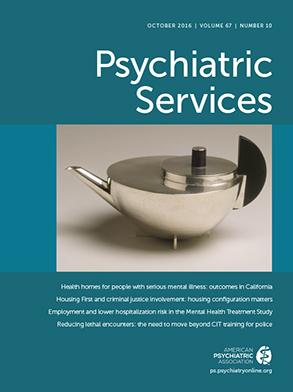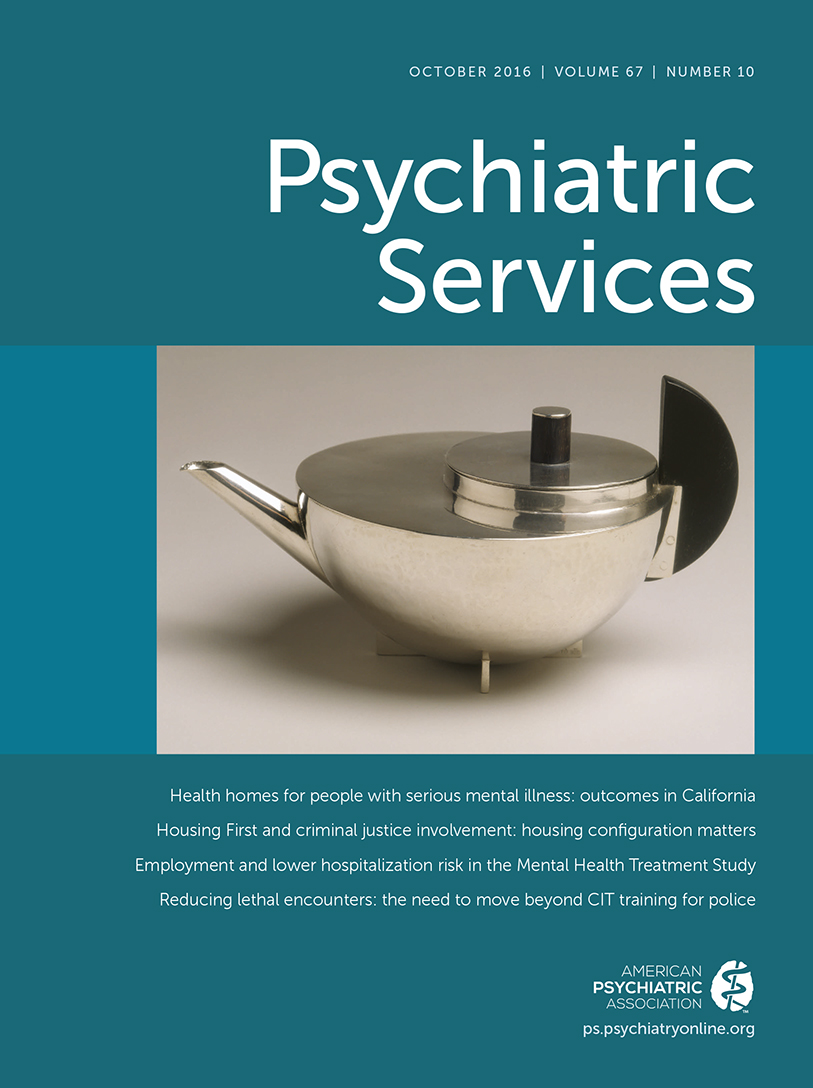Recent growth in use of electronic health records (EHRs) by physician practices has the potential to help increase rates of treatment for anxiety disorders. EHRs enable the collection of structured information relating to anxiety symptoms and cue physicians to offer treatments, such as counseling or medication.
While the prevailing thought is that EHRs may improve quality of care (
4), the empirical evidence for this proposition does not provide universal support. There is even some evidence of a negative association between EHR use and care quality (
5). One of the potential reasons for these unintended consequences is that EHRs may replace physician-patient interactions with physician-computer interactions (
6). More broadly, physicians’ cognitive performance and use of information may be affected, positively or negatively, by EHRs and the clinical work processes in which they are implemented (
7,
8). For example, EHR systems may be designed in a way that focuses physicians’ attention on treating general medical conditions rather than mental health conditions. Several studies have demonstrated that EHRs are associated with more frequent discussions between patients and physicians about biomedical issues but may lead to reduced exchanges about psychosocial topics (
9,
10).
The purpose of this study was to test the association, at a visit level, between the receipt of anxiety treatment and the presence of EHRs in a physician practice. Accordingly, we examined whether the probability of receiving anxiety treatment during a visit to a primary care practice for anxiety differed between practices with and without an EHR. We hypothesized that anxiety treatment would be less likely to be offered during visits to primary care practices with a fully implemented EHR compared with visits to primary care practices without a fully functioning EHR.
Methods
The study used data from the 2007–2010 National Ambulatory Medical Care Survey (NAMCS), a nationally representative probability sample survey of physician office visits in the United States that is conducted annually by the National Center for Health Statistics (
11). Physician office visits included in NAMCS are those delivered as outpatient care in freestanding, office-based practices, including health maintenance organizations (HMOs) and nonfederal government clinics. In this study, we limited visits to primary care practices, a setting that may be particularly vulnerable to poor anxiety care because physicians must manage numerous health concerns (
12).
The NAMCS uses a three-stage sampling design selecting primary sampling units (PSUs), physician practices within PSUs, and patient visits within practices. Physicians are asked to record information on a standardized form for sampled office visits made over a randomly selected one-week period during the year. This form contains up to three patient-reported reasons for the visit and up to three physician diagnoses per visit based on ICD-9 codes as well as medications and other treatment provided, ordered, or continued. During the three-year period for this study, physician participation rates averaged 61.3%.
In this study, visits for anxiety disorders were identified as all visits in which the patient identified anxiety as the reason for the visit (codes 11000, 11050, 11301, and 11305) and the physician recorded a diagnosis of anxiety state, unspecified (300.0), or panic disorder (300.01), generalized anxiety disorder (300.02), other anxiety state (300.09), phobic disorders (300.2×), obsessive-compulsive disorder (300.3), acute stress reaction (308.0), transient adjustment reaction (309.24), adjustment reaction with mixed emotional features (309.28), and prolonged posttraumatic stress disorder (309.81). [A table showing the characteristics of the weighted sample stratified by presence of an EHR is available as an online supplement to this report.]
Receipt of medication to treat anxiety was defined as physician notation that an antianxiety agent (benzodiazepines or buspirone) or any antidepressant used to treat anxiety disorders had been prescribed, ordered, supplied, administered, or continued for a patient. Drugs included in the class of antianxiety agents were alprazolam, buspirone, chlordiazepoxide, clorazepate, diazepam, halazepam, lorazepam, and oxazepam. Antidepressant medications included amitriptyline, amoxapine, bupropion, citalopram, clomipramine, desipramine, doxepin, duloxetine, escitalopram, fluoxetine, fluvoxamine, imipramine, isocarboxazid, maprotiline, mirtazapine, nefazodone, nortriptyline, paroxetine, phenelzine, protriptyline, sertraline, tranylcypromine, trazodone, trimipramine, and venlafaxine. Receipt of mental health counseling was defined as physician notation that psychotherapy or mental health counseling was provided or ordered at the visit, which includes referrals. Therefore, any ongoing treatment of anxiety, regardless of whether it was initiated during the visit, was captured in the visit data. Three dummy variables were created to indicate whether the patient was currently being prescribed an antianxiety or antidepressant medication, was receiving any mental health counseling, and was receiving any anxiety treatment, defined as either medication or mental health counseling.
The NAMCS includes information about practice characteristics, EHR use, and other capabilities using computer technology. Physicians were asked if their practice had an EHR, and if so, whether it was partially (some paper records) or fully (no paper records) implemented. The final component of EHR implementation is physician functionality (
13); therefore only practices that indicated full implementation of an EHR were defined as EHR practices. Practices that reported partial implementation of EHR or no EHR were defined as non-EHR practices.
Among visits included in this study’s sample, we used multivariate logistic regression to compare the odds of being treated with antianxiety medication, mental health counseling, or combined anxiety treatment (medication and mental health counseling) in EHR practices versus non-EHR practices. In the logistic regressions models, we controlled for patients’ age, gender, race-ethnicity, type of insurance, number of physician visits in the previous year, region of practice, median income for their zip code, and number of chronic conditions. The analyses also controlled for whether the practice was physician or privately owned, was a community health center, was HMO owned, or was part of an academic medical center. All analyses used the survey procedures of Stata, version 13.0, to allow for estimates to be nationally representative and for standard errors to correctly account for the complex sampling strategy of the NAMCS, with 95% confidence intervals (CIs) calculated by using these weights for all estimated odds ratios (ORs). This study was certified as exempt by the University of Florida Institutional Review Board.
Discussion
Having a fully implemented EHR was associated with a statistically significant reduction in the odds of receiving antianxiety medication. Moreover, our findings also show that having a fully implemented EHR was associated with a sizable reduction in odds of receiving mental health counseling or any anxiety treatment; however, these results were significant only at the p=.06 level. Given the magnitude of the effect sizes and the negative consequences associated with anxiety disorders (
2), our study highlights an important opportunity to improve health outcomes at a population level.
Although it was not possible to explain this phenomenon by using NAMCS data, there is some evidence that clinical workflows embedded in EHRs may encourage physicians to focus on biomedical concerns, decreasing the likelihood that mental health counseling is offered or referred. Unintended consequences of EHRs and other health information technologies have been documented previously (
6). Studies have also shown that EHR interfaces create additional work for physicians by forcing them to click through multiple options and screens and requiring them to perform tasks that had previously been handled by other office staff, such as placing orders (
8,
14). These changes in tasks and workflow not only may reduce the amount of time that physicians spend looking at patients instead of their computers during their interactions but also may reduce physicians’ cognitive performance, given that they may be thinking about their interactions with the computer rather than the patient’s clinical condition.
Regardless of the underlying mechanism, studies that continue to show evidence of national-level differences in care delivery between EHR and non-EHR practices (
15) point to a compelling need for more rigorous EHR design, implementation, and evaluation to ensure that EHRs achieve their widely promoted benefits to care quality and outcomes. Moreover, as other countries implement EHRs, they should consider the implications of this study and other evidence highlighting the potential for disparate clinical decision making and care quality between EHR and non-EHR practices (
15).
It is important to acknowledge this study’s small sample (N=290). The small sample size is likely reflective of the fact that we focused our analysis on visits in which both the patient and the physician acknowledged the presence of anxiety.
The study also had other limitations. Given the study’s nonexperimental design, we were unable to draw a causal inference between EHRs and reduced rates of psychosocial treatment. It is possible that other unobserved differences between EHR and non-EHR practices may be driving the results. For example, patient treatment preference or disease severity could confound the results. Specifically, it is possible that patients who prefer not to be treated with mental health counseling or who have lower levels of anxiety severity self-select into EHR practices, but this explanation seems unlikely. Another limitation arose from the likelihood that patients with a previous diagnosis of an anxiety disorder were not identified because of coding errors or missed diagnoses. However, this study sought to mitigate this possibility by using only visits for treatment of anxiety, indicated by both the patient’s reason for the visit and the diagnosis given by the physician. Finally, limitations arose from the NAMCS data. NAMCS has limited clinical measures; therefore, the ability to control for patient complexity and severity was restricted. Furthermore, NAMCS does not contain data regarding practice size, ownership, and geographic location. Primary care practices that are smaller and independently owned are less likely to have an EHR (
13). However, we assume that such practices are less likely to offer anxiety treatment, thereby biasing the results toward the null. Despite the NAMCS limitations, this data set provides the most comprehensive national survey of EHR use in physician offices.

